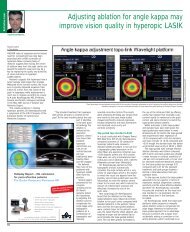ESCRS Guidelines on prevention, investigation and management of
ESCRS Guidelines on prevention, investigation and management of
ESCRS Guidelines on prevention, investigation and management of
Create successful ePaper yourself
Turn your PDF publications into a flip-book with our unique Google optimized e-Paper software.
3. Diagnosis<br />
3.1 Commencement <strong>and</strong> symptoms<br />
Acute early endophthalmitis after cataract operati<strong>on</strong>s commences between the first post-operative day <strong>and</strong><br />
approximately two weeks after the operati<strong>on</strong>. It is associated in 74 to 85 per cent with ocular pain <strong>and</strong> in ><br />
90 per cent with reduced visi<strong>on</strong> [15], [122]. It is characterised in 75 to 86 per cent by hypopy<strong>on</strong>, in > 80<br />
per cent by a red eye <strong>and</strong> in 35 per cent by lid swelling [141]. Additi<strong>on</strong>ally, there can be corneal oedema<br />
<strong>and</strong> involvement <strong>of</strong> the posterior segment (refer to chart below) [205].<br />
Chr<strong>on</strong>ic late endophthalmitis after cataract operati<strong>on</strong>s commences <strong>on</strong>ly after two weeks but may also take<br />
many m<strong>on</strong>ths to appear [50], [96], [113], [117]. It is usually caused by Propi<strong>on</strong>ibacterium acnes, S.<br />
epidermidis (CNS), diphtheroids <strong>and</strong> fungi [15], [122]. In P. acnes endophthalmitis, whitish plaques are<br />
found in the capsular sac in 40 to 89 per cent [50], [62], [205]. Hypopy<strong>on</strong> is found in 67 per cent, corneal<br />
oedema in 48 per cent <strong>and</strong> keratitis in 26 per cent <strong>of</strong> cases <strong>of</strong> fungal endophthalmitis [113], [124];<br />
pyramid-shaped hypopy<strong>on</strong> is typical <strong>of</strong> a mycotic cause [204], [210]. Refer to chart below.<br />
The course <strong>and</strong> final outcome depend <strong>on</strong> the type <strong>and</strong> number <strong>of</strong> pathogens. In 44 to 53 per cent there is<br />
an achievement <strong>of</strong> <strong>on</strong>ly <strong>on</strong>e metre visi<strong>on</strong> with bacterial infecti<strong>on</strong> [15], [122], <strong>and</strong> similar for fungal infecti<strong>on</strong><br />
in 41 to 70 per cent <strong>of</strong> patients [113], [151]. Endophthalmitis after pars plana vitrectomy has a poorer<br />
prognosis than after cataract or glaucoma surgery [46], [63].<br />
The diagnosis <strong>of</strong> acute bacterial endophthalmitis is a medical emergency requiring an immediate vitreal tap<br />
<strong>and</strong> instillati<strong>on</strong> <strong>of</strong> intravitreal antibiotics <strong>and</strong> corticosteroid.<br />
Figure 3.1 Early presentati<strong>on</strong> <strong>of</strong> acute endophthalmitis<br />
due to Streptococcus mitis<br />
(Courtesy <strong>of</strong> Suleyman Kaynak)<br />
Figure 3.2 Presentati<strong>on</strong> <strong>of</strong> acute endophthalmitis<br />
due to Staphylococcus aureus<br />
(Courtesy <strong>of</strong> Uwe Pleyer)<br />
15





